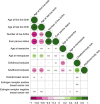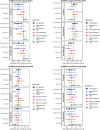Assessing the causal and independent impact of parity-related reproductive factors on risk of breast cancer subtypes
- PMID: 41034901
- PMCID: PMC12487161
- DOI: 10.1186/s12916-025-04375-6
Assessing the causal and independent impact of parity-related reproductive factors on risk of breast cancer subtypes
Abstract
Background: Observational evidence proposes a protective effect of having children and an early first pregnancy on breast cancer development; however, the causality of this association remains uncertain. Here, we assess whether parity-related reproductive factors impact breast cancer risk independently of each other and other causally related or genetically correlated factors: adiposity, age at menarche, and age at menopause.
Methods: We used genetic data from UK Biobank for reproductive factors and adiposity, and the Breast Cancer Association Consortium for risk of overall, estrogen receptor (ER) positive and negative breast cancer, and breast cancer subtypes. We applied univariable and multivariable Mendelian randomization (MR) to estimate genetically predicted direct effects of ever parous status, ages at first birth and last birth, and number of births on breast cancer risk.
Results: We found limited evidence for a genetically predicted protective effect of an earlier age at first birth on breast cancer risk. While the univariable analysis revealed later age at first birth decreased ER-negative breast cancer risk (odds ratio (OR): 0.76; 95% confidence interval: 0.61, 0.95 per standard deviation (SD) increase in age at first birth), this effect attenuated with separate adjustment for age at menarche (potential confounder) (OR: 0.83; 0.62, 1.06) and age at menopause (genetically correlated factor) (OR: 0.80; 0.66, 1.01). Furthermore, we found evidence that a later age at first birth decreased HER2-enriched breast cancer risk but only after adjusting for number of births (potential mediator) (OR: 0.28; 0.11, 0.57 per SD increase in age at first birth). In the multivariable analysis, we found little evidence for genetically predicted effects of ever-parous status, age at last birth, or number of births on breast cancer risk; however, analyses of ever-parous status and age at last birth were limited by weak instruments.
Conclusions: This study found minimal evidence of a genetically predicted protective effect of earlier age at first birth on breast cancer risk, while identifying some evidence for a genetically predicted adverse effect on ER-negative breast cancer risk. However, weak instruments limited the multivariable analysis of ever parous status and age at last birth, which may be improved with larger sample sizes.
Keywords: BCAC; Breast cancer risk; Mendelian randomization; Reproductive factors; UK Biobank.
© 2025. The Author(s).
Conflict of interest statement
Declarations. Ethics approval and consent to participate: UK Biobank received ethical approval from the North West Multi-Centre Research Ethics Committee (REC reference: 16/NW/0274) and was conducted in accordance with the principles of the Declaration of Helsinki. Consent for publication: This manuscript does not include details, images or videos relating to an individual person; therefore, consent for publication is not required, beyond the informed consent provided by all study participants as described above. Competing interests: The authors declare no competing interests.
Figures




References
-
- Kelsey JL, Gammon MD, John EM. Reproductive factors and breast cancer. Epidemiol Rev. 1993;15(1):36–47. - PubMed
-
- Britt K, Ashworth A, Smalley M. Pregnancy and the risk of breast cancer. Endocr Relat Cancer. 2007;14(4):907–33. - PubMed
-
- Asztalos S, Gann PH, Hayes MK, Nonn L, Beam CA, Dai Y, et al. Gene expression patterns in the human breast after pregnancy. Cancer Prev Res (Phila). 2010;3(3):301–11. - PubMed
-
- Russo IH, Russo J. Role of hormones in mammary cancer initiation and progression. J Mammary Gland Biol Neoplasia. 1998;3(1):49–61. - PubMed
MeSH terms
Grants and funding
LinkOut - more resources
Full Text Sources
Medical
Research Materials
Miscellaneous

